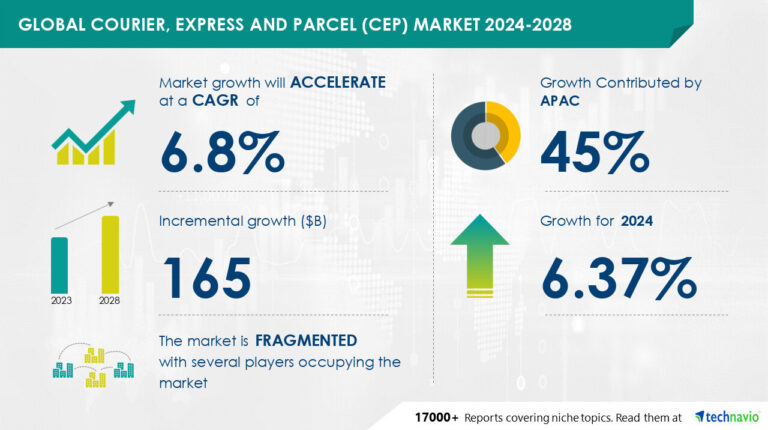A new report from Technavio has revealed the global courier, express and parcel (CEP) market is expected to grow by US$165bn during 2024-2028, with a rise in free trade agreements (FTAs) in CEP markets in emerging economies driving growth.
According to the Global courier, express and parcel (CEP) market 2024-2028 report, there is a growing trend for last-mile delivery model integration with e-commerce vendors, driven by the increasing demand for instant delivery services.
This growth is particularly noticeable in the instant delivery market, where high capital investments are being made in startups and venture firms. The e-commerce sector is responding by introducing new delivery models, such as hub-and-spoke and last-mile delivery, to cater to customer needs. These models include postal mail run, crowd shipping, courier delivery, and delivery to lockers.
Key trends
Despite the popularity of instant delivery, price remains a key decision factor for over half of online customers. However, for certain product categories like medicines and groceries, customers prefer traditional purchasing methods due to longer delivery times.
According to the report, domestic and international shipping volumes are on the rise, with a particular focus on e-commerce and B2B transactions. Technologies such as automation and real-time tracking are trending, allowing for more efficient and transparent operations. Delivery companies are also expanding their networks and services, offering new options like same-day and overnight delivery.
Additionally, the use of manufacturing hubs and distribution centers is becoming more common to reduce delivery times and costs. Overall, the CEP market is evolving to meet the changing needs of consumers and businesses alike.
Industry challenges
The report also reveals CEP market challenges, such as increased competitiveness because of new players, including startups and merging companies, entering the scene. These new entrants use technology and attractive freight rates to gain an edge.
The logistics industry’s potential for technological advancements, such as robotics and ICT, remains untapped due to digitalization and labor training challenges. Partnerships between industry players and technology providers, as well as global companies’ entry, are driving the CEP industry’s digital transformation, leading to cost savings, improved efficiency, and service quality assurance. This transformation may pose a threat to market growth in the forecast period.
Another major challenge highlighted by the report is the increasing demand for faster delivery, particularly in the e-commerce sector, as well as the need to maintain a large and dispersed network of delivery centers and transportation fleets to ensure timely delivery.
Domestic and international regulations also pose challenges in terms of compliance and documentation requirements. Additionally, the rise of digital technologies and automation necessitates significant investment in IT infrastructure and systems upgrades. Markets can be segmented based on services offered, such as on-demand, scheduled and same-day delivery, and by regions including North America, Europe, Asia-Pacific, and others. Competition is intense, with major players including UPS, FedEx, DHL, and TNT, among others.
For more insights, download a sample report.


